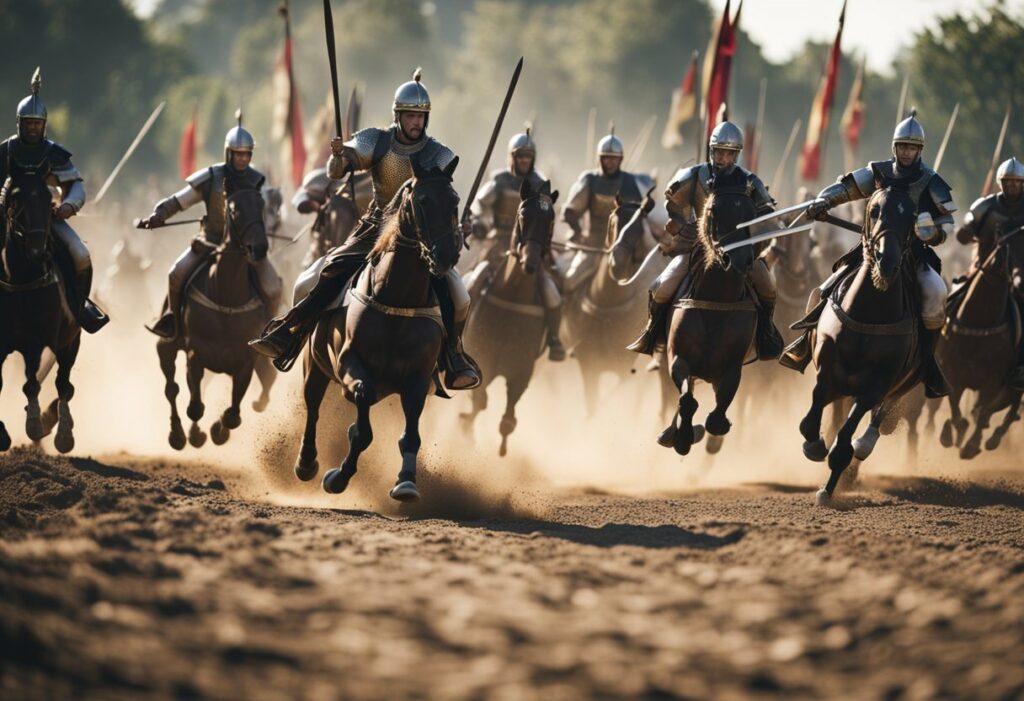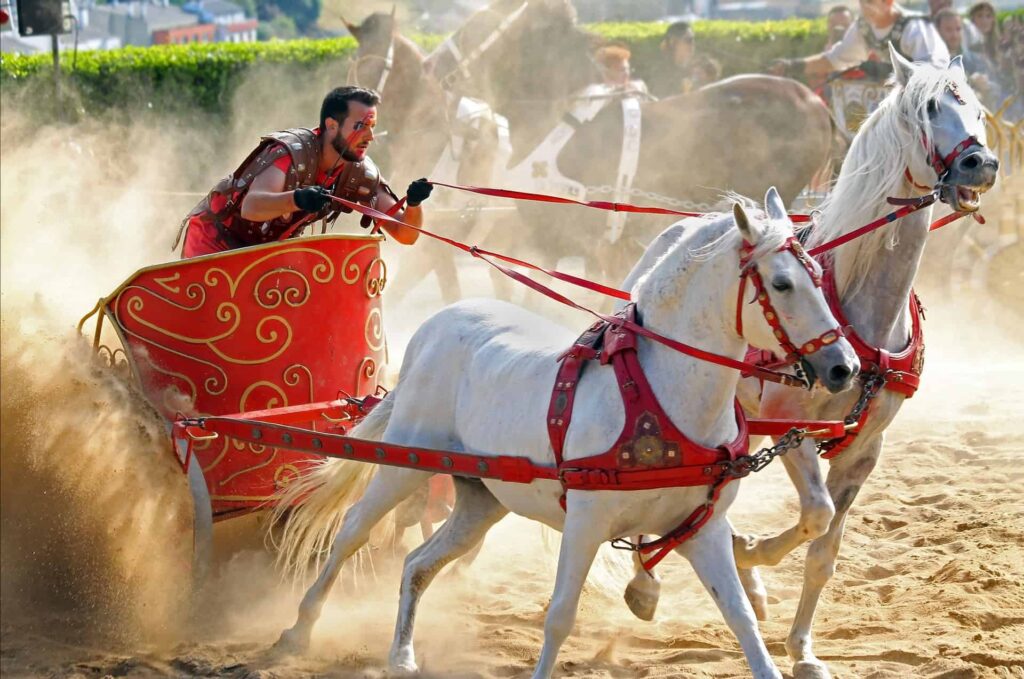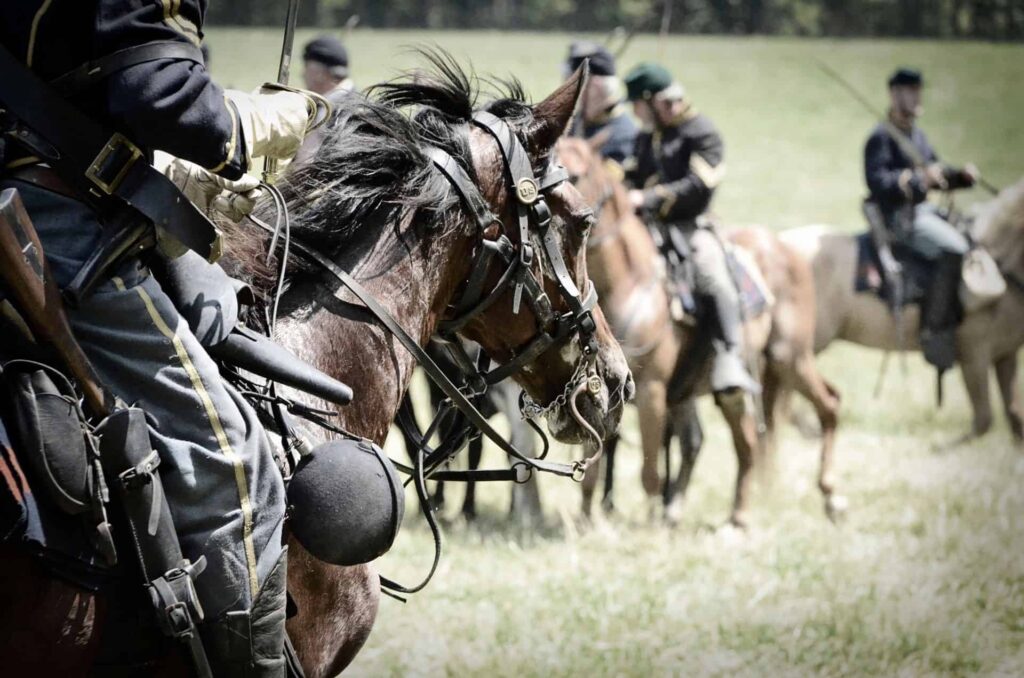The Roman cavalry played a vital role in the military success of the Roman Empire. Although initially less significant compared to the powerful infantry legions, the cavalry evolved over time to become a key part of Roman military strategies. They were responsible for various tasks, such as reconnaissance, skirmishing, and protecting flanks during battles.
The origins of Roman cavalry can be traced back to the early years of the Roman Republic, where its primary purpose was to support the infantry on the battlefield. As Rome expanded its territories, the demand for a more effective cavalry force increased, leading to the development of various types of cavalry units, such as the auxilia (non-citizen troops) and the alae (wings). These specialized units were equipped with different weapons and armor, and their tactics were adapted to the terrain and enemies they faced.
Throughout its existence, the Roman cavalry underwent a series of transformations, both in its organization and equipment, to suit changing warfare demands. Numerous battles demonstrated the importance of a versatile and well-trained cavalry for the Romans, while their role in society revealed the complex relationship between military service and Roman citizenship.
Key Takeaways
- Roman cavalry evolved from a supporting role to a crucial component of Roman military strategies.
- Specialized cavalry units were developed to face diverse terrains and enemies.
- The Roman cavalry’s transformations throughout history reflected the broader changes within Roman society and warfare.
Origins of Roman Cavalry
The Roman cavalry played a crucial role in the Roman army during its early history, particularly in the period of the Roman Republic. One of the earliest accounts of Roman cavalry can be traced back to the reign of Servius Tullius, the sixth king of Rome. He is credited with organizing the Roman army into distinct units, including the mounted cavalry known as eques.
The eques class originally consisted of wealthy citizens who could afford to maintain a horse for battle. They were not only used for combat, but also served as messengers and scouts due to their superior mobility. As Rome expanded its territories, the role of the cavalry in the Roman military establishment became more critical, providing support to infantry units and engaging in reconnaissance missions.
During the Roman Republic, the eques were divided into turmae, each containing 30 horsemen. These turmae were further grouped into larger units, known as Alae, each commanded by a Decurio. The Alae were typically composed of Roman citizens, while allied cavalry units were also incorporated into the Roman forces. These auxiliary troops played a significant role in Rome’s military conquests, contributing to the army’s versatility and adaptability on the battlefield.
Throughout Roman military history, the use of cavalry evolved alongside advancements in tactics and technology. Although the cavalry never surpassed the importance of the infantry in the Roman army, their role remained crucial in achieving victory in various campaigns. The Roman cavalry’s ability to adapt, and the integration of allied forces, were instrumental in shaping the history of the Roman Republic and the subsequent Roman Empire.
Organization and Ranks
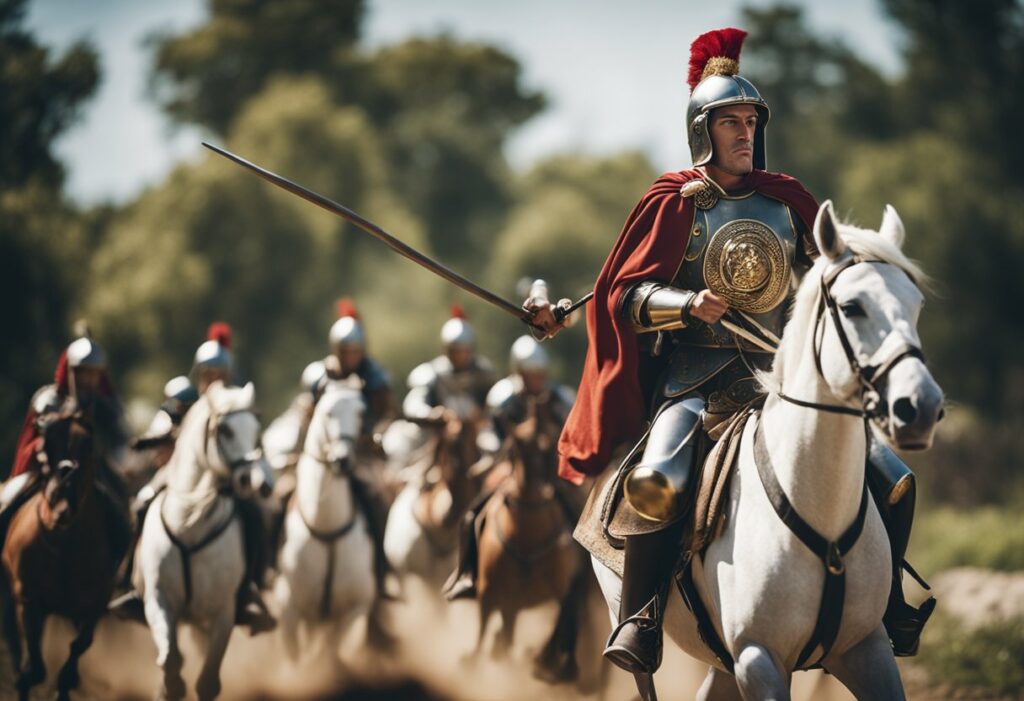
The Roman cavalry played a crucial role in the military operations of the Roman army. They were primarily divided into two main categories: the Legion and the Auxilia. The Legion was composed of Roman citizens, while the Auxilia consisted of non-citizen soldiers, who often provided additional support in battle.
In the Roman cavalry, the basic unit was a Turma, which consisted of 30-40 horsemen. Each Turma was led by a Decurio, who was responsible for overseeing the horsemen’s training and tactics during the battle. A larger unit known as an Alae, was comprised of various Turmae, and formed a more significant contingent within the Roman army. The Alae were often employed for scouting missions, flanking maneuvers, and other specialized tasks during battle.
The cavalry of the Roman Legion was typically commanded by an Eques Legionis, a high-ranking officer who was part of the Legion’s broader command structure. However, this cavalry played a secondary role to the infantry and was primarily utilized for strategic and tactical purposes.
On the other hand, in the Auxilia cavalry units, the organization was more diverse. These units were usually commanded by a Praefectus or a Tribunus who led several Alae. The leader of an Alae was known as a Praefectus Alae. Auxilia cavalry was more prominent and important to the Roman army, as it was composed of skilled horsemen and fighters from various regions and cultures.
Apart from the Legion and Auxilia, another element of the Roman cavalry was the Imperial Horse Guard, a prestigious unit that served as personal protectors of the Roman emperor. These elite horsemen were handpicked based on their skills and loyalty and often enjoyed high status and privileges within the Roman army.
The Roman cavalry was a vital component of the Roman army, with a well-defined structure. The Legion and the Auxilia were two central parts, each with their organization and roles. The Legion predominantly focused on supporting the infantry, while the Auxilia, with its diverse and skilled soldiers, played an instrumental role in various battlefield tasks. The clear organization of ranks and units within the Roman cavalry contributed to its efficiency and efficacy, ultimately helping the Roman army dominate the battlefield for centuries.
Role of Roman Cavalry
Battlefield Role
In the Roman army, cavalry played a significant role on the battlefield, offering both offensive and defensive capabilities. They were primarily responsible for protecting the flanks of the infantry during battle, utilizing their speed and mobility to counter enemy cavalry and outmaneuver foot soldiers. Roman cavalry also played a crucial role in scouting and skirmishing tasks ahead of the main force, providing valuable intelligence on enemy positions and movements.
On the offensive, Roman cavalry engaged in pursuits, utilizing their speed to chase down retreating enemies and prevent them from regrouping. They were particularly effective in disrupting enemy formations, using their superior mobility and reach to harass and create openings for the infantry to exploit.
Tactical Role
Roman cavalry were highly versatile in their tactical roles, adapting their functions according to the demands of the battlefield. Some of their responsibilities included reconnaissance, scouting, and providing support to the infantry.
- Reconnaissance: Roman cavalry units were often tasked with gathering critical information about the enemy’s intentions and movements, enabling commanders to make informed decisions on the positioning and engagement of their forces.
- Scouting: Cavalry units served as the eyes of the Roman army, scouting ahead of the main force to detect potential threats and identify advantageous terrain. They ensured that Roman infantry could advance safely and maintain a secure line of communication and supply.
- Infantry Support: In addition to protecting the flanks, Roman cavalry also bolstered the main fighting force with auxiliary troops and supplies. They provided a rapid response to any breakthroughs, using their speed and agility to counter enemy advances and protect vulnerable areas of the battle line.
Roman cavalry played a vital role in both the battlefield and tactical aspects of horse warfare. Their abilities to scout, pursue, and provide support to the infantry made them an integral component of the Roman military machine.
Equipment and Armament
Armor and Protection
Roman cavalry was well-equipped with various forms of armor and protection. The soldiers often wore a combination of mail armor andlorica segmentata. Protective gear like helmets and greaves (shin guards) were also common among the cavalry. Helmets were often adorned with decorative plumes and provided vital protection for the head during combat.
One of the core pieces of protection for Roman cavalrymen was the shield, which was usually a large, rectangular, curved piece of wood or metal called the scutum. The scutum protected the soldier from enemy projectiles and helped them to deflect blows from melee weapons.
The horses of some Roman cavalry units were also equipped with chamfrons (horse head armor) and chest guards, offering protection to both rider and steed.
Weapons
Roman cavalry utilized a diverse array of weapons depending on their role on the battlefield and the particular period of Roman history. Common weapons included the spear, lance, and spatha.
- Spear: The spear was a versatile weapon for cavalry, used both for thrusting and throwing. It allowed the rider to maintain distance from the enemy and strike from a safe range.
- Lance: Similar to the spear, the lance was another favorite cavalry weapon. It was a longer, heavier weapon, designed for charging and impaling opponents. Some Roman lancers, known as contarii, would lean their substantial weight into the lance for maximum impact during a charge.
- Spatha: The spatha was a type of longsword used by some Roman cavalry units. It replaced the earlier gladius, which was better suited for infantry combat. The spatha provided increased reach, making it effective for slashing attacks from horseback while maintaining distance from the enemy.
Roman cavalry, along with their mail armor, often carried two or more weapon types simultaneously to offer versatility and adaptability in different combat situations. The Roman cavalry’s equipment and armament played a significant role in their battlefield effectiveness and contributed to the expansion and dominance of the Roman Empire.
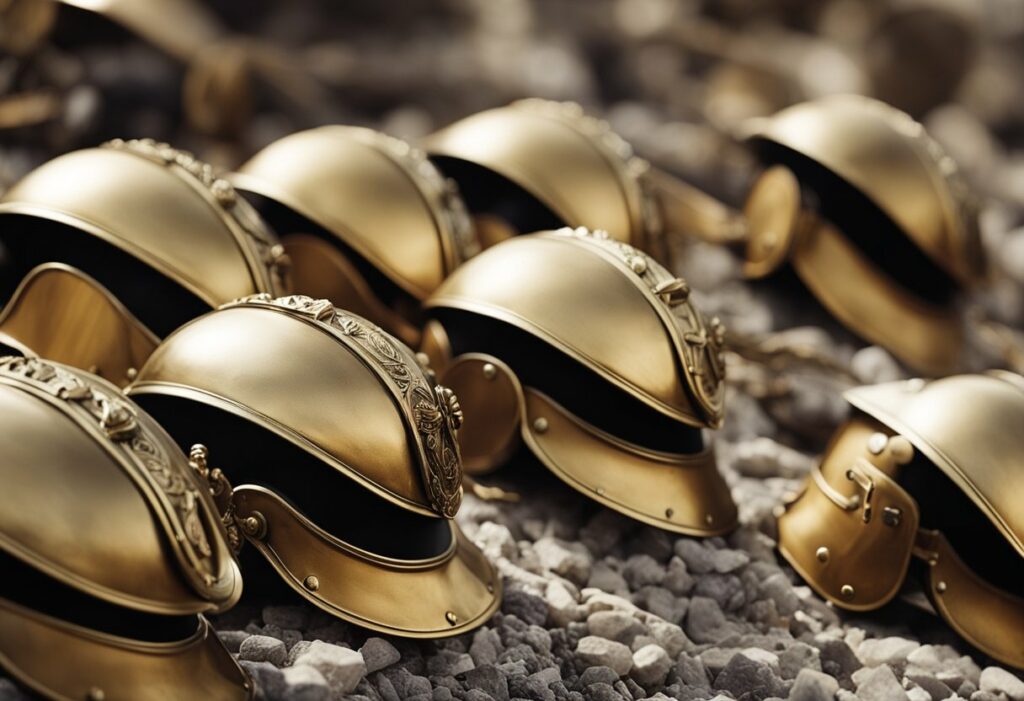
Key Battles and Tactics
Second Punic War
The Second Punic War (218-201 BC) featured several key Roman cavalry engagements, which significantly impacted the outcomes of various battles. One of the notable examples is the Battle of Cannae in 216 BC, where Roman cavalry faced Hannibal’s forces. Hannibal’s tactical brilliance was evident in his use of the double envelopment maneuver, which resulted in a devastating defeat for the Romans.
During this battle, the Roman center had a high concentration of infantry, whereas the flanks were primarily composed of cavalry units. On the other hand, Hannibal placed his elite African infantry at the center, with various contingents of forces on their flanks. Greek allies supported the Carthaginian cavalry on both flanks, making them formidable adversaries.
The Roman cavalry, inexperienced and ill-prepared compared to their counterparts, struggled to repel the opposing forces. The Carthaginians and their Greek allies continuously outflanked the Romans, causing chaos and instability in their ranks. The Roman center, predominantly composed of infantry, eventually broke and fled, leading to a massive loss that cemented Hannibal’s position as one of history’s greatest tacticians.
Battle of Zama
The Battle of Zama in 202 BC marked the end of the Second Punic War. Roman general Scipio Africanus faced Hannibal in North Africa, where he displayed advanced cavalry tactics that ultimately contributed to a decisive Roman victory. This time, the Roman forces were better prepared and equipped to deal with the Carthaginian cavalry and war elephants.
Scipio deployed his forces in a different manner compared to previous Roman tactics, organizing infantry in three lines and placing a key emphasis on the cavalry. The Roman cavalry was positioned on the wings, with the intention of outflanking and neutralizing their Carthaginian counterparts. Roman forces utilized strategic gaps in their lines to lure the war elephants into corridors, rendering them ineffective.
During the battle, the Roman cavalry displayed their improved communication and adaptability, successfully counteracting Hannibal’s own cavalry. As the Carthaginian cavalry began to waver, the Romans seized the opportunity and attacked their flanks, subsequently defeating them. This victory marked a turning point in Roman warfare tactics and demonstrated the growing significance of cavalry in their military strategies.
Roman Cavalry Types
Light and Heavy Cavalry
Roman cavalry was generally divided into two main types: light and heavy cavalry. Light cavalry, known as equites or cavalrymen, were typically used for reconnaissance, skirmishing, and providing support to infantry units, such as the legionaries. They were often equipped with lighter armor and weapons, allowing for greater speed and mobility on the battlefield.
Heavy cavalry, on the other hand, played a more decisive role in combat. These units were often better armed and armored than their light cavalry counterparts, making them formidable forces in battle. One example of heavy cavalry is the cataphracts – heavily armored horsemen armed with lances or other long-reaching weapons. They were known for their ability to charge and break through enemy lines, as well as providing strong support for infantry units.
Mounted Archers
Beyond light and heavy cavalry, the Roman army also employed mounted archers. These specialized troops were a combination of the mobility and versatility of cavalry with the long-range capabilities of archers. Mounted archers were often used for both harassment and supporting infantry engagements, particularly when facing infantry-heavy enemy forces.
Some of the most famous mounted archers in Roman history were the clibanarii, who were heavily armored archers mounted on armored horses. Clibanarii combined the power of a heavy cavalry unit with the precision of archery, making them a versatile and effective force on the battlefield.
Evolution of the Roman Cavalry
Republic to Empire
During the early years of the Roman Republic, the cavalry played a secondary role in the infantry legions, but as Rome expanded, the need for a more mobile force led to the development of better-equipped, professional cavalry units. Caesar and Augustus, two of Rome’s most famous leaders, revolutionized Rome’s cavalry tactics and organization.
Caesar reformed the Roman cavalry, adding more Turmae — formations consisting of 30–40 soldiers. These Turmae were assigned to legions and supported infantry in battle. Caesar is known for his innovative tactical integration of cavalry and infantry, which contributed to his military success. These changes marked a shift from the older, more decentralized Roman cavalry to a better-organized and more professional force.
Under Augustus, the first Roman Emperor, the Roman cavalry continued to evolve. He restructured the military, creating distinct units of cavalry and infantry within the Roman legions. With the rise of the Roman Empire, the cavalry became vital for maintaining control over vast territories, and their role and importance within the Roman army grew.
Late Empire Changes
During the later years of the Roman Empire, emperors such as Diocletian made further significant changes to the Roman cavalry. They diversified the types of cavalry units and expanded the use of mounted forces, which allowed the Roman army to adapt to new challenges.
Diocletian reevaluated the traditional Roman military structure, integrating heavy and light cavalry and even introducing heavily armored cataphract-style horsemen, which increased the tactical flexibility of the Roman army. This shift in cavalry tactics and organization contributed to the success of the Roman Empire during its later years.
The Roman cavalry’s evolution from the Republic to the Empire and through the Late Empire changes demonstrated Rome’s ability to adapt its military forces to new challenges and ensure their continued success. This aspect of Roman military history showcases their prowess and the impact these reforms had on the outcomes of battles and the fate of the Roman Empire.
Recruitment and Citizenship
Citizen Soldiers
The Roman army was known for its well-organized recruitment system that involved enlisting both citizens and non-citizen subjects. Citizen soldiers were typically the Roman citizens who qualified for service in the legions. They were entrusted with the responsibility of serving in the cavalry and infantry units within the Roman military. Their service in the cavalry units can be traced back to the early Roman Empire, where citizens were organized into 300 cavalry squadrons.
The process of recruitment for Roman citizens was systematic, with the Roman military conducting periodic censuses to identify eligible citizens for service. Once enlisted, citizen soldiers underwent rigorous training to become skilled fighters and commanders. Serving in the military not only provided a sense of pride and honor but also conferred certain privileges such as land grants and exemption from certain taxes.
Non-Citizen Soldiers
Non-citizen soldiers, also known as auxiliaries, usually served alongside Roman citizen soldiers. Although they were not Roman citizens themselves, they were a necessary part of the Roman military machine. These soldiers were recruited from the provinces and were often incorporated into cavalry and infantry units as well. Through their service in the Roman military, auxiliaries had the opportunity to gain Roman citizenship along with their family members.
Auxiliaries were usually trained in similar ways to their citizen counterparts, focusing on the specific skills and tactics required for their units. Their roles in the Roman military were diverse and crucial for maintaining control over the vast empire. Roman auxiliaries were known to be reliable, effective, and highly valued by the Roman military command.
The recruitment of both citizen and non-citizen soldiers was a factor in the growth and success of the Roman cavalry. The inclusion of auxiliaries allowed the Roman military to enhance its capabilities and reinforce its ranks, while the service of Roman citizens maintained a sense of pride and loyalty to the empire. Together, these two groups of soldiers contributed significantly to the strength and effectiveness of the Roman military throughout its history.
The Roman Cavalry in Society
The Equestrian Class
The Equestrian Class, also known as the “equites,” played a vital role in Roman society. They were the social group situated between the lower-class plebeians and the upper-class patricians, possessing considerable wealth and status. Originating as a group of wealthy citizens who could afford to serve in the Roman cavalry, the Equestrian Class eventually expanded its influence in politics, the military, and the economy.
One of the significant military reforms attributed to this class is the Marian Reforms, which transformed the Roman army by providing landless citizens an opportunity to serve, equipping them at the state’s expense, and ensuring a more professional fighting force.
Cavalry and Politics
Members of the Equestrian Class were not only involved in the military aspect of Roman society but also played crucial roles in politics. Their wealth and connections allowed them to assume roles in the administration, governance, and financial management of the empire. As a result, they became influential in shaping the Roman political landscape.
Part of this political involvement included positions within the Praetorian Guard, an elite unit of the Roman army. They were responsible for protecting important dignitaries and ensuring the safety of the empire. The Praetorian Guard’s officers often held key leadership positions in the government, further highlighting the significance of the Equestrian Class in Roman politics.
In the Roman military, the Equestrian Class supplied officers to the cavalry and held various ranks such as Centurions and Primus Pilus, reinforcing their prominent status both socially and politically. These roles not only allowed them to command the troops but also provided opportunities for social and political connections.
The Roman cavalry played a significant role in shaping the social and political landscape of the empire. The Equestrian Class, once primarily serving as cavalry members, expanded its influence to various sectors in Roman society, including politics and the military. Their position in society allowed them to contribute to the empire’s growth and stability through the Marian Reforms, involvement in the Praetorian Guard, and serving in key military ranks.
Frequently Asked Questions
What were the Roman cavalry ranks?
The Roman cavalry had various ranks, with the most notable ones being decurions, who were in charge of a unit of 10-30 cavalrymen, and dux, a higher-ranking officer commanding multiple units. Each rank played a crucial role in maintaining the discipline and structure of the Roman cavalry.
How effective was Roman cavalry?
Roman cavalry was an critical component of the Roman military machine, known for its flexibility and effectiveness in battle. They were often used in coordination with infantry for flanking and reconnaissance operations. Due to their training, tactics, and equipment, Roman cavalry played a significant role in the expansion and defense of the Roman Empire.
What were the typical Roman cavalry tactics?
Roman cavalry tactics included using shock and mobility to create an advantage in battle. The cavalry would often be deployed on the flanks of the infantry, engaging the enemy with swift charges, followed by sudden retreats – a tactic known as “cantabrian circle”. This movement enabled them to harass and wear down enemy forces while avoiding direct confrontation with heavily armed and armored opponents.
What was the role of Roman auxiliary cavalry?
The Roman auxiliary cavalry comprised non-citizen troops recruited from the provinces, which were critical in supporting the primary Roman cavalry. They provided valuable expertise in local terrain, culture, and fighting techniques. Equipped and trained similarly to the main Roman cavalry, the auxiliary cavalry played an key role in scouting, skirmishing, and flanking enemy forces during Roman military campaigns.
Why did Romans rely less on heavy cavalry?
Heavy cavalry requires more resources for training and maintaining both the soldiers and their horses, which may have deterred the Romans from relying heavily on this type of force. The Roman military placed a higher emphasis on infantry tactics, using their superior coordination and discipline to achieve victories. This reliance on infantry lessened the need for a significant heavy cavalry presence in their armies.
What type of armor and weaponry did Roman cavalry use?
Roman cavalry was typically equipped with a combination of chainmail or scale armor for protection, and a variety of weapons for offense, including the spatha (a long sword), lancea (a light lance), and the contus (a long spear). They also carried small, round shields called parma for more defense. This assortment of weaponry allowed Roman cavalry to effectively engage in both close combat and skirmishing actions on the battlefield.
Sources
https://www.academia.edu/download/37348989/Wiley.ERA.Rance.Cavalry.Late.Empire.pdf
Last Updated on October 30, 2023 by Nate Dewsbury
